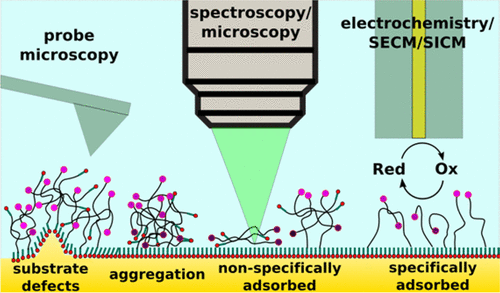Our official English website, www.x-mol.net, welcomes your
feedback! (Note: you will need to create a separate account there.)
Beyond Simple Cartoons: Challenges in Characterizing Electrochemical Biosensor Interfaces
ACS Sensors ( IF 8.2 ) Pub Date : 2018-01-12 00:00:00 , DOI: 10.1021/acssensors.7b00840 Dan Bizzotto 1 , Ian J. Burgess 2 , Thomas Doneux 3 , Takamasa Sagara 4 , Hua-Zhong Yu 5
ACS Sensors ( IF 8.2 ) Pub Date : 2018-01-12 00:00:00 , DOI: 10.1021/acssensors.7b00840 Dan Bizzotto 1 , Ian J. Burgess 2 , Thomas Doneux 3 , Takamasa Sagara 4 , Hua-Zhong Yu 5
Affiliation

|
Design and development of surface-based biosensors is challenging given the multidisciplinary nature of this enterprise, which is certainly the case for electrochemical biosensors. Self-assembly approaches are used to modify the surface with capture probes along with electrochemical methods for detection. Complex surface structures are created to improve the probe–target interaction. These multicomponent surface structures are usually idealized in schematic representations. Many rely on the analytical performance of the sensor surface as an indication of the quality of the surface modification strategy. While directly linked to the eventual device, arguments for pursuing a more extensive characterization of the molecular environments at the surface are presented as a path to understanding how to make electrochemical sensors that are more robust, reliable with improved sensitivity. This is a complex task that is most often accomplished using methods that only report the average characteristics of the surface. Less often applied are methods that are sensitive to the probe (or adsorbate) present in nonideal configurations (e.g., aggregates, clusters, nonspecifically adsorbed). Though these structures may compose a small fraction of the overall modified surface, they have an uncertain impact on sensor performance and reliability. Addressing this issue requires application of imaging methods over a variety of length scales (e.g., optical microscopy and/or scanning probe microscopy) that provide valuable insight into the diversity of surface structures and molecular environments present at the sensing interface. Furthermore, using in situ analytical methods, while complex, can be more relevant to the sensing environment. Reliable measurements of the nature and extent of these features are required to assess the impact of these nonideal configurations on the sensing process. The development and use of methods that can characterize complex surface based biosensors is arguably required, highlighting the need for a multidisciplinary approach toward the preparation and analysis of the biosensor surface. In many ways, representing the surface without reliance on overly simplified cartoons will highlight these important considerations for improving sensor characteristics.
中文翻译:

超越简单的卡通:表征电化学生物传感器接口的挑战
考虑到该企业的多学科性质,基于表面的生物传感器的设计和开发具有挑战性,电化学生物传感器的情况当然如此。自组装方法用于通过捕获探针以及电化学检测方法对表面进行修饰。创建复杂的表面结构以改善探针与目标的相互作用。这些多组分表面结构通常以示意图形式理想化。许多依赖传感器表面的分析性能作为表面改性策略质量的指标。虽然直接与最终设备相关联,但仍提出了寻求对表面分子环境进行更广泛表征的论据,以此作为了解如何使电化学传感器更坚固耐用,可靠,灵敏度更高。这是一项复杂的任务,通常使用仅报告表面平均特征的方法来完成。对非理想配置(例如,聚集体,团簇,非特异性吸附)中存在的探针(或被吸附物)敏感的方法很少采用。尽管这些结构可能只占整个修饰表面的一小部分,但它们对传感器性能和可靠性的影响不确定。为了解决这个问题,需要在各种长度范围内应用成像方法(例如,光学显微镜和/或扫描探针显微镜),这些方法可提供有关传感界面处表面结构和分子环境多样性的宝贵见解。此外,使用原位分析方法虽然很复杂,可能与感应环境更相关。需要对这些特征的性质和范围进行可靠的测量,以评估这些非理想配置对传感过程的影响。可以说,需要开发和使用能够表征复杂的基于表面的生物传感器的方法,这突显了对制备和分析生物传感器表面的多学科方法的需求。在许多方面,不依赖过度简化的卡通人物来表示表面将突出这些重要的考虑因素,以改善传感器的特性。可以说,需要开发和使用能够表征复杂的基于表面的生物传感器的方法,这突显了对制备和分析生物传感器表面的多学科方法的需求。在许多方面,不依赖过度简化的卡通人物来表示表面将突出这些重要的考虑因素,以改善传感器的特性。可以说,需要开发和使用能够表征复杂的基于表面的生物传感器的方法,这突显了对制备和分析生物传感器表面的多学科方法的需求。在许多方面,不依赖过度简化的卡通人物来表示表面将突出这些重要的考虑因素,以改善传感器的特性。
更新日期:2018-01-12
中文翻译:

超越简单的卡通:表征电化学生物传感器接口的挑战
考虑到该企业的多学科性质,基于表面的生物传感器的设计和开发具有挑战性,电化学生物传感器的情况当然如此。自组装方法用于通过捕获探针以及电化学检测方法对表面进行修饰。创建复杂的表面结构以改善探针与目标的相互作用。这些多组分表面结构通常以示意图形式理想化。许多依赖传感器表面的分析性能作为表面改性策略质量的指标。虽然直接与最终设备相关联,但仍提出了寻求对表面分子环境进行更广泛表征的论据,以此作为了解如何使电化学传感器更坚固耐用,可靠,灵敏度更高。这是一项复杂的任务,通常使用仅报告表面平均特征的方法来完成。对非理想配置(例如,聚集体,团簇,非特异性吸附)中存在的探针(或被吸附物)敏感的方法很少采用。尽管这些结构可能只占整个修饰表面的一小部分,但它们对传感器性能和可靠性的影响不确定。为了解决这个问题,需要在各种长度范围内应用成像方法(例如,光学显微镜和/或扫描探针显微镜),这些方法可提供有关传感界面处表面结构和分子环境多样性的宝贵见解。此外,使用原位分析方法虽然很复杂,可能与感应环境更相关。需要对这些特征的性质和范围进行可靠的测量,以评估这些非理想配置对传感过程的影响。可以说,需要开发和使用能够表征复杂的基于表面的生物传感器的方法,这突显了对制备和分析生物传感器表面的多学科方法的需求。在许多方面,不依赖过度简化的卡通人物来表示表面将突出这些重要的考虑因素,以改善传感器的特性。可以说,需要开发和使用能够表征复杂的基于表面的生物传感器的方法,这突显了对制备和分析生物传感器表面的多学科方法的需求。在许多方面,不依赖过度简化的卡通人物来表示表面将突出这些重要的考虑因素,以改善传感器的特性。可以说,需要开发和使用能够表征复杂的基于表面的生物传感器的方法,这突显了对制备和分析生物传感器表面的多学科方法的需求。在许多方面,不依赖过度简化的卡通人物来表示表面将突出这些重要的考虑因素,以改善传感器的特性。











































 京公网安备 11010802027423号
京公网安备 11010802027423号